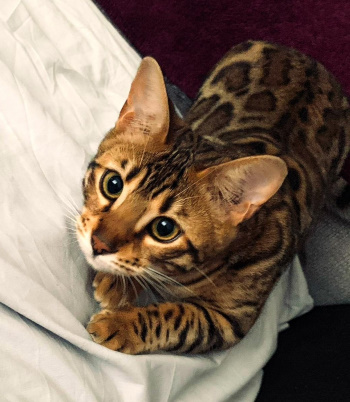GOOD TO KNOW
The Bengal cat is a very active animal.

In 1960’s, an American biologist Jean Mill came up with an initiative to create a new domesticated cat breed that resembles leopards. To fulfil her goal she began to inbreed house cats with Bengal cats (Prionailurus Bengalensis) - wild mammals from the cat family. During the inbreeding process she ended up adding American short-haired, Abyssinian and Egyptian Mau cats into the gene pool. The first two litter (F1 and F2) turned out to be too similar to their wild father- not only by fur pattern, but character traits alike. These cats were absolutely not suitable for people seeking a household pet. In addition to this, they were infertile. Only in further generations they lost their ‘wildness’ and became less skittish and aggressive towards humans.
In 1991, the Bengal cat gene pool was further enriched through adding two female cats from the Bristol breed into the kennel. These cats were hybrids of a house cat and a wild South American margay. It’s because of their genes that we received cats with a striking wild appearance and beautiful rosettes.

Appearance
A Bengal cat is a large, heavily built cat. The kitten's weight is about 3 kg, but males are much heavier, they weigh between 5 to 9 kg, and still Bengal doesn't give the impression of a sluggish cat, its muscular build with smooth, elegant movement gives out a feeling of a wild cat.
They have a triangle head shape with rounded contours, it is quite wide and small in relation to rest of the body with a smooth forehead including broad muzzle and a straight nose. They have large beautiful eyes set wide apart and slightly cornered.
They don't have large ears but they are set high, slightly inclined forward. There impressive muscular body is without doubt very strong, with a long, strong tail, rounded at end.
Bengal's fur is its main characteristic. Hair is short, very dense and thick with a soft touch. The colour of it is yellow or black with a touch of gold. Bengals do have spots. There are passports on the cheeks and the letter M on the forehead. A dark stripe runs along the spine and the side of the ears. A characteristic "thumbprint". On the stomach are typical dark dots that also occur on the outside parts of the paws.

Nature
The Bengal cat is a very active animal. The cat gives out a lot of sounds, depending on the occasion it can be growling, mewing or tweet. Bengals are also very intelligent, you can teach them many tricks like opening the door or unscrewing the tap in sink.
It's one of the few breeds of cats that would allow you to go on a walk on a leash. They become attach to their guardian very much. Breeders call their bengals "cat dogs" because these animals have many dog traits, they come well being call, they can fetch or even welcome you at the doorstep of the apartment. Bengals are brave, happy, but treat strangers with distance. They are very friendly to other animals. They are not afraid of water, they sometimes bathe in the bathtub with the owner.
Well raised from a kitten bengal has no hint of aggression. They are very calm.
BEAUTY BENGAL FARM
MALGORZATA WYROBA
ANDOVER, ENGLAND
+44 7583023660
+44 7472902411
E-MAIL: info@beautybengal.com


